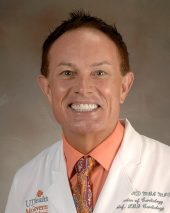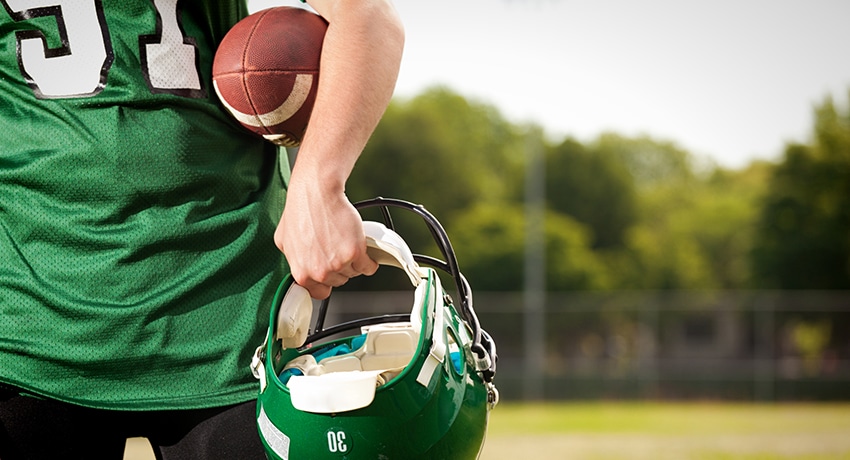Sudden cardiac arrest (SCA) is the leading cause of death in young athletes, but this reality probably never rang so true until the evening of Jan. 2. That is when millions of Americans witnessed 24-year-old Damar Hamlin, safety for the Buffalo Bills, collapse on live television after completing a tackle.

“There are a number of causes for sudden cardiac arrest in athletes who are 35 and younger,” said John P. Higgins, MD, MBA, MPhil, professor of cardiovascular medicine with McGovern Medical School at UTHealth Houston and sports cardiologist with the Houston Rockets. “Sometimes it can just be a normal heart at the wrong place and the wrong time.”
In the case of Hamlin, a blunt injury to his chest may have led to commotio cordis.
“He got hit right in front of the heart on his chest by the helmet of another player,” Higgins said. “The mechanical energy from a force like that, whether it comes from another player or an object like a baseball or hockey puck, disrupts the heart’s electrical impulses and causes commotio cordis.”
Commotio cordis is an event where a blunt, non-penetrating trauma to the chest results in irregular heart rhythm and ventricular fibrillation leading to SCA. This does not allow the heart to pump blood to the rest of the body, and the person collapses.
“Exercise demands more blood flow, but if the heart cannot pump the necessary supply of blood, it can ultimately lead to sudden cardiac arrest,” he said.
The main culprit of SCA in young athletes, however, is not commotio cordis or another form of arrhythmia. The leading cause in the U.S. is hypertrophic cardiomyopathy, while congenital coronary artery anomaly is the second. Both of these conditions make it harder for the heart to pump blood to the rest of the body.
“Hypertrophic cardiomyopathy is a disease of the heart muscle. It starts to become too thick and stiff for blood to fill the heart and be pumped out effectively,” Higgins said. “Some hypertrophic cardiomyopathy patients are predisposed to ventricular arrhythmia and SCA.”
“A congenital coronary artery anomaly is a heart defect,” he continued. “An artery is in the wrong place, or coming from the wrong place, and not allowing proper blood flow to supply necessary oxygen and nutrients to the heart.”
There are several more cardiac conditions that can lead to SCA. These include inherited or acquired cardiomyopathies (e.g., arrhythmogenic right ventricular, myocarditis); electrical disorders and channelopathies (e.g., Brugada syndrome, Long QT syndrome, Wolff-Parkinson-White syndrome); valve and aortic disorders (e.g., Marfan syndrome, pulmonary stenosis); coronary artery anomalies; and congenital heart disease.
Most SCA cases are due to genetics rather than injuries.
“Most of the conditions that can lead to sudden cardiac arrest in young athletes are hereditary. A person can be born with a hereditary or congenital heart condition that is never detected,” he said.
Student athletes or students involved in vigorous physical activities should receive additional screening if a family member has a hereditary or congenital heart condition.
“For student athletes, screening was normally just medical history questions and a physical exam. The data shows that history and physicals will only detect 5% to 25% of cases of athletes that have underlying conditions associated with SCA,” the cardiologist said. “In other words, with traditional screening you’re going to miss most of them.”
Higgins advocated for Texas House Bill 76, or Cody’s Law, which was passed in 2019. It requires school districts to provide information on SCA and electrocardiograms (ECGs) to parents of student athletes. Higgins recommends an ECG for any at-risk student.
“If your child has any indications — chest pains, heart palpitations, or easily out of breath from exercise — or a medical history, an ECG can raise the detection rate significantly for many of the conditions that cause SCA, from 25% at best to about 80%,” he said. “While the ECG is not perfect, it appears to be better than the current history and physical.”
Because not every heart condition may be detected, it is important for all sports facilitators to learn CPR and have access to defibrillators.
“If you can’t prevent a sudden cardiac arrest, you can definitely try to bring the person back as fast as possible,” Higgins said. “Perform CPR until the person can be shocked into a normal heart rhythm with a defibrillator.”
It is also necessary to keep all athletes well hydrated.
“Make sure they are given plenty of water because dehydration can cause strain on the heart, and this may also lead to events which could in turn result in sudden cardiac arrest,” he said.
Though there are some risks, the doctor asserts that “exercise is medicine.” The former marathoner and daily runner believes sports still offer more health benefits than risks.
“For parents who are very concerned about SCA, they can try putting their child in a non-contact sport, like swimming, tennis, cross-country, or rowing,” Higgins said. Perhaps more padding equipment can be introduced into certain sports as well as advanced training and raised awareness of coaches and players.”
“There is room for improvement, but I don’t believe sudden cardiac arrest is a reason to not play sports,” he added.


